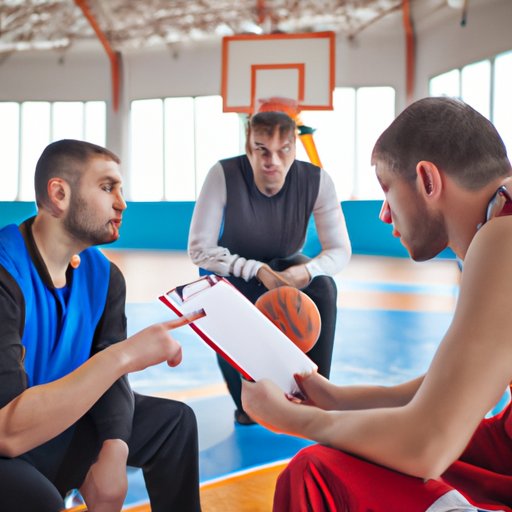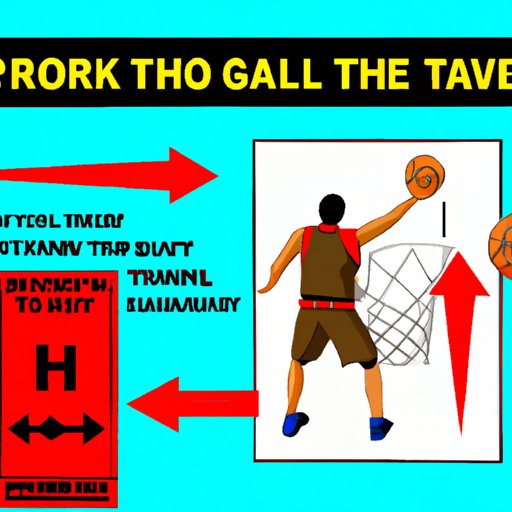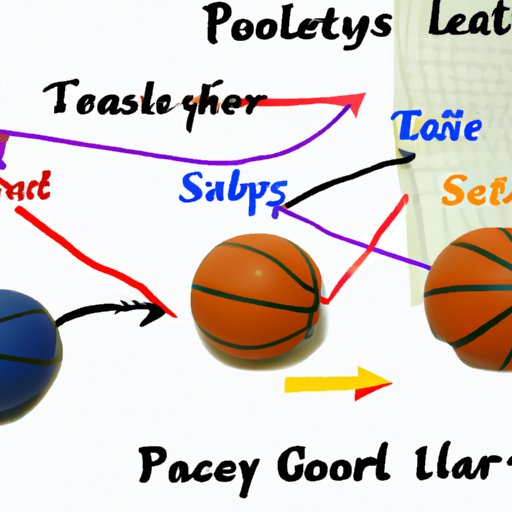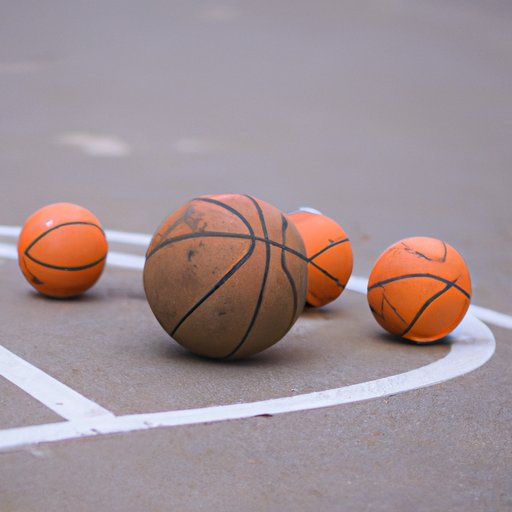Introduction
Traveling in basketball is a common infraction that occurs when a player moves his feet or pivots with the ball in an illegal manner. It’s important for all players, from beginners to professionals, to understand the rules and regulations surrounding traveling in order to play the game properly and avoid unnecessary penalties. This article will explore the basics of travel in basketball, examine the rules and consequences of traveling, provide a guide to avoiding travel, discuss the technicalities of travel, look at the strategic aspects of travel, analyze how travel affects the outcome of a game, and investigate the impact of travel on player performance.
Exploring the Basics of Travel in Basketball
Before diving into the rules and consequences of travel in basketball, it’s important to first understand what traveling is and how it differs from other fouls.
What is Travel?
Traveling is defined as “any movement of the pivot foot, or feet, once the dribble has been started, which causes the offensive player to cover more than two steps without bouncing the ball on the floor.”1 In other words, traveling occurs when a player takes more than two steps while holding the ball without dribbling it. The most common way this happens is when a player begins a dribble, takes two steps, and then picks up the ball and continues moving without dribbling it again. This is considered traveling because the player has moved more than two steps without dribbling the ball.
How is Travel Different from Other Fouls?
Traveling is different from other types of fouls in that it does not involve contact between players. For example, a player may be called for a personal foul if he makes contact with an opposing player while dribbling or shooting. However, traveling is not a contact foul and is instead based solely on the number of steps taken by the player with the ball. As such, it is important for players to be aware of their movements and make sure they do not take more than two steps without dribbling the ball.

Examining the Rules and Consequences of Traveling in Basketball
The rules and penalties for traveling vary depending on the governing body. The National Basketball Association (NBA) and the National Collegiate Athletic Association (NCAA) have different rules and consequences for traveling.
NBA Rules on Traveling
In the NBA, a player is allowed to take two steps after beginning a dribble, but must then pass, shoot, or begin another dribble. If a player takes three or more steps after beginning the dribble, he will be called for traveling. Additionally, a player cannot pick up his pivot foot and put it back down in the same spot unless he has passed, shot, or dribbled the ball. If a player does so, he will be called for traveling. 2
NCAA Rules on Traveling
In the NCAA, a player is allowed to take two steps after beginning a dribble, but must then pass, shoot, or begin another dribble. If a player takes three or more steps after beginning the dribble, he will be called for traveling. Additionally, a player cannot lift his pivot foot and move it before passing, shooting, or dribbling the ball. If a player does so, he will be called for traveling. 3
Penalties for Traveling
In both the NBA and the NCAA, traveling is considered a violation and is penalized accordingly. In the NBA, if a player is called for traveling, the opposing team is awarded possession of the ball. In the NCAA, if a player is called for traveling, the opposing team is awarded one free throw and possession of the ball. 4

A Guide to Avoiding Travel in Basketball
The best way to avoid traveling in basketball is to become familiar with the rules and practice proper dribbling technique. Below are some tips to help players stay within the rules and avoid traveling.
Steps to Take When Dribbling
When dribbling, it is important to keep your head up, use your fingertips, and maintain control of the ball. Additionally, it is important to take short, quick steps rather than long strides. This will help you stay within the two-step limit and avoid traveling. 5
Ways to Position Yourself to Avoid Traveling
It is also important to position yourself properly when dribbling. Make sure you have enough space between you and the defender to make a move without taking more than two steps. You should also be aware of your surroundings and anticipate where the defender will be going in order to avoid traveling. 6

Understanding the Technicalities of Travel in Basketball
In addition to understanding the rules and practicing proper dribbling technique, it is important to understand the technicalities of travel in basketball. This includes the role of the referee and the different types of traveling calls.
The Role of the Referee
The referee is responsible for making all calls related to travel in basketball. The referee must observe the player with the ball and determine whether he has taken more than two steps without dribbling or has lifted his pivot foot and moved it before passing, shooting, or dribbling the ball. If the referee determines that the player has committed a traveling violation, he will call a traveling foul. 7
Different Types of Traveling Calls
There are several different types of traveling calls that a referee may make. These include double-dribbling, walking, and carrying. Double-dribbling occurs when a player takes two steps with the ball and then dribbles it again. Walking occurs when a player takes three or more steps with the ball without dribbling it. Carrying occurs when a player lifts his pivot foot and moves it before passing, shooting, or dribbling the ball. 8
The Strategic Aspects of Travel in Basketball
In addition to understanding the technicalities of travel in basketball, it is important to consider the strategic aspects as well. This includes using travel as a tool in offense and taking advantage of opponents’ lack of awareness.
Using Travel as a Tool in Offense
Although travel is generally considered a negative thing in basketball, it can be used strategically in certain situations. Some teams use travel as a tool to create open shots or break the press. This can be effective if done correctly, but it is important to remember that traveling is still a violation and can result in a penalty. 9
Taking Advantage of Opponents’ Lack of Awareness
Another way to use travel strategically is to take advantage of opponents’ lack of awareness. If a defender is not paying attention, a player can take more than two steps without dribbling the ball and get away with it. This can be effective, but it is important to remember that referees are trained to recognize traveling violations and can call a foul if they see one. 10

Analyzing How Travel Affects the Outcome of a Basketball Game
In addition to using travel strategically, it is also important to consider how travel can affect the outcome of a basketball game. This includes how travel can change the momentum of a game and its potential impact on team strategies.
How Travel Can Change the Momentum of a Game
Traveling can have a significant impact on the momentum of a game. If a player is called for traveling, the opposing team is awarded possession of the ball, which can give them the opportunity to score or gain a defensive advantage. Additionally, traveling can lead to frustration among players and coaches, which can negatively impact a team’s performance. 11
Potential Impact on Team Strategies
Traveling can also have an impact on team strategies. If a team is trying to press or run a fast break, traveling can disrupt those plans and give the opposing team an opportunity to counter. Additionally, if a team is trying to slow the game down and limit possessions, traveling can give the opposing team extra opportunities to score. 12
Investigating the Impact of Travel on Player Performance
Finally, it is important to consider how travel can affect the performance of individual players. This includes the physical and mental effects of travel as well as how it impacts confidence.
Physical and Mental Effects
Traveling can have a negative physical and mental effect on players. Physically, it can contribute to fatigue due to the extra running and jumping required to avoid traveling. Mentally, it can cause frustration and distractions that can negatively impact a player’s performance. 13
How Travel Impacts Confidence
Traveling can also have an impact on a player’s confidence. A player who is constantly being called for traveling may become discouraged and lose confidence in his ability to dribble and make plays. Additionally, a player who is consistently getting away with traveling may become overconfident and take unnecessary risks that could lead to turnovers or other mistakes. 14
Conclusion
Traveling in basketball is a common infraction that occurs when a player moves his feet or pivots with the ball in an illegal manner. It is important for players to understand the rules and consequences of traveling in order to play the game properly and avoid unnecessary penalties. This article explored the basics of travel in basketball, examined the rules and consequences of traveling, provided a guide to avoiding travel, discussed the technicalities of travel, looked at the strategic aspects of travel, analyzed how travel affects the outcome of a game, and investigated the impact of travel on player performance. Overall, it is clear that traveling can have a significant impact on the game and should be avoided whenever possible.
(Note: Is this article not meeting your expectations? Do you have knowledge or insights to share? Unlock new opportunities and expand your reach by joining our authors team. Click Registration to join us and share your expertise with our readers.)
